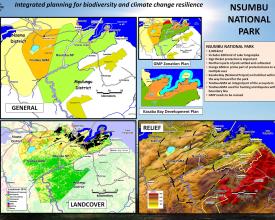
Integrating climate change aspects in protected areas management planning in Zambia

Climate change is increasingly being recognized as a major threat that will not only present new risks and threats to Protected Areas (PAs) but also will exacerbate existing threats and vulnerabilities. For many PAs, current conservation objectives, strategies and actions will need to be revised to best meet the challenges posed by climate change.
The above withstanding, the Department of National Parks and Wildlife with technical support from IUCN undertook to integrate climate change aspects in the Nsumbu National Park (Zambia) General Management Planning. This involved the design of climate change adaptation measures aimed at improving park resilience to climate change.
One of the immediate impacts of the solution include improved capacity of park managers to address climate change and increased public awareness on the impacts of climate change on ecological and social systems. Full scale implementation of the solution will result into improved park resilience to climate change.
Context
Challenges addressed
The challenges addressed are both technical and social:
- Lack of recognition of the role of protected areas in achieving adaptation and mitigation goals by key actors
- Limited access to climate and biodiversity data for conservation and development planning
- Technical capabilities: low technical capacity to integrate climate change considerations into protected area management planning
Location
Process
Summary of the process
The six building blocks are closely related.
Capacity building on climate change resilience (BB1): Improved stakeholder capacity clearly enhanced their participation in the assessment of climate change vulnerability and land use (BB2), development of climate change strategy (BB 3), revision of the GMP
(BB 4) and communication of the climater smart GMP (BB 5)
Likewise, knowledge and skills gained, and information generated, during the assessment of land use and climate change vulnerability (BB2) is critical for the development of the climate change strategy (BB 3) and the review of the GMP (BB 4). The development of the park climate change strategy (BB 3) and review of the GMP (BB 4) contributes to improved capacity on climate change resilience (BB 1) and consequently enhanced skills on the assessment of vulnerability and land use (BB 2 ).
Communication of the climate smart GMP (BB 5) contributes to better capacity on park climate resilience (BB 1), climate change vulnerability and land use assessment (BB 2), development of a park climate change strategy (BB 3) and also revision of the GMP (BB 4).
Building Blocks
Capacity building on climate change resilience
The purpose of this block is to build capacity of park managers on climate change through workshops focusing on topics that are very specific to climate change issues encountered at the park level.
A series of capacity building workshops were held in Lusaka (national level) and Kasama (provincial/local level) in 2017 to raise awareness on key concepts related to climate change including impacts, vulnerability and resilience in relation to protected areas. The workshops were attended by delegates from the Department of National Parks and Widlife, Department of Natural Resources Management, Northen Provincial Administration, Nsama District Council, Mpulungu Town Council, Nsumbu National Park, NGOs (e.g. Conservation Lake Tanganyika - CLT and Frankfurt Zoological Society - FZS) and Programmes such as Lake Tanganyika Development Project (LTDP).
The workshops provided participants with key information and knowledge on climate aspects needed in the next steps of integrating climate change in the Park General Management Plan.
Enabling factors
- Availability of interested, motivated and commited stakeholders
- Effective communication skills
Lesson learned
- Capacity building should not be an on-off event, rather a continous undertaking aimed at enhancing the capacity of both park managers and stakeholders including local communities living adjacent to protected areas.
- The commitment and increased empowerment of communities is important for the sustainability of the solution.
- Monitoring and evaluation must accompany the process to ensure that awareness and capacity is actually improved
Assessment of climate change vulnerability and land use
The purpose of this block is to assess biodiversity vulnerability to climatic and non-climatic stressors (e.g. land use changes). Assessment is a prerequisite for any action to measure the conservation status of biodiversity and the resilience to climate change. These evaluations also help to better guide the identification of appropriate climate change adaptation interventions.
The assessment of climate change vulnerability and land use was done by touring the Nsumbu National Park and adjacent GMA namely Tondwa and Kaputwa, key informant interviews and through desk review. While site visits aimed at obtaining crucial information through observation, desk review was conducted to augment field information. The assessment was led by experts accompanied by park managers. Leaders - men and women the adjacent villages who have a better understanding of the park and surrounding areas participated in the process.
Enabling factors
- Inventory of traditional knowledge on biodiversity and weather / climate change.
- Availability and access to scientific baseline data on biodiversity and climate change.
- Ability to visualize past, present and future status of biodiversity in the context of climatic and non-climatic stressors
Lesson learned
Reviewing existing data on climate change is critical to understanding the past and future trends of climate change at the regional and national level.
Site visits in and around the park helps to provide information on the ground status of land uses and biodiversity / ecosystems. Specifically, direct observation provides information on the threats and challenges facing biodiversity and also on the visible signs of climate induced droughts, floods, etc.
Local communities, particularly villagers who have lived longer near / around the Natioanl Park have a better understanding of local changes on climate and biodiversity. As such capturing this information for validating and complementing global and regional data and developing a vision with communities is critical to designing appropriate adaptation strategies.
Development of a park climate change strategy
Informed by the climate change vulnerability and land use assessment, the framing of climate change adaptation objectives and strategies was undertaken aimed at improving park resilience to climate change.
The climate change adaptation objectives and strategies were reviewed by stakeholders at a workshop held in Lusaka in October 2017. The workshop was attended by park managers from Department of National Parks and Wildlife, Nsumbu National Park and others. Inputs provided by stakeholders was used to further develop the adaptation objectives and strategies into a park climate change strategy. The strategy included a goal, scope and objectives, adaptation strategies as well as implementation and monitoring plans. key indicators and parameters for monitoring changes in vulnerability and resilience were also included.
Another workshop was held in December 2017 in Lusaka to validate the climate change strategy. The workshop was attended by Ministry of Tourism and Arts and Ministries responsible for Environment, and Natural Resources as well as key Departments and Agencies. Others were representatives from Nsumbu National Park, Nsumbu-Mweru Wantipa Management Area, Lake Tanganyika Development Project. The final park climate change strategy was to be integrated into & annexed to the GMP.
Enabling factors
- Participation of stakeholders with knowledge on climate change variability and change and biodiversity
- Facilitation by a climate change and natural resource expert.
- Access to updated climate (and biodiversity) information
Lesson learned
- Stakeholder participation is key to designing appropriate adaptation measures with the potential of improving resilience to climate change. Thus, stakeholders, including communities adjacent to protected areas, should be involved in the identification and validation of climate change adaptation and mitigation measures.
- The identification of relevant adaptation and mitigation measures requires that the process if facilitated by a qualified climate change expert with a good understand of the regional, national and local context.
- The availability of up to date baseline data, both scientific and indigenous, on climate change aspects informs the designing of relevant adaptation measures
Reviewing of the Park General Management Plan to include climate resilience aspects
This block addresses the work of revising the management plan so that it integrates aspects related to climate change resilience.
It was agreed during the National Validation Workshop held in December 2017 in Lusaka between the Department of National Parks and Wildlife and the Lake Tanganyika Development Programme (the funder of the GMP review) and other key stakeholders that the Nsumbu GMP will be reviewed in 2018 to include climate change aspects by pulling together information from the approved climate change strategy. Further it was agreed that the Park Climate Change Strategy will be annexed to the revised GMP.
As of March 2019, the review of the GMP is ongoing and expected to be completed towards the end of this year.
Enabling factors
Key enabling factors in this BB include:
- Stakeholder awareness on climate change impacts and adaptation strategies for protected areas
- Effective facilitation of the GMP review process by qualified experts
- Effective stakeholder participation in the review process
Lesson learned
To better integrate climate change aspects, emerging lessons show that its is critical to:
- Rivise the protected areas management planning framework to include climate change. This would allow for the integration of climate change during the GMP development, rather than the review process
- Review existing biodiversity threats to include climate change.
- Revise management objects to capture climate change resilience.
Communicating the climate smart GMP to stakeholder
The purpose of this block is to raise the awareness of stakeholders on the climate smart GMP through communication by means adapted especially to the realities of the park area. The media to use depends on the level of intervention. For example, community radio and posters can be used to educate local people; online platforms are useful for a wide audience at the national and international level; and brochures are useful for visitors etc
Enabling factors
Appropriate communication strategies that take into account the literacy levels, linguistic knowledge and other socio-cultural factors.
Lesson learned
Early lessons learned include:
- Communicating the climate smart GMP ensures that stakeholders are aware of the climate change aspects and that their interest is generated and their commitment is secured to participate in the implementation and respect of the GMP as a Park Management tool.
- Communicating the climate change strategy will enable stakeholders to provide feedback, via mornitoring and evaluation, on the effective of the strategy in delivering the intended resilience objectives.
Impacts
The solution is anticipated to deliver social and environmental benefits - both short term and long term.
The short term benefits include:
- Improved understanding by park managers and the general public about climate change impacts on and vulnerability of of biodiversity and ecosystems and adjacent communities
- Enhanced capacity of park managers and other stakeholders to design and implement priority strategies for adaptating to and mitigating climate change.
- increased recognition of the role that protected areas can play in supporting the adaptation of eocystems and local communities to changing climatic conditions by maintaining the flow of ecosystem services and mitigating the impacts of climate change by sequestering carbon.
Following the implementation of adaptation and mitigation measures, the key anticipated long term positive impact of the solution is the reduction of vulnerability to climate change impacts hence improved climate resilience of park biodiversity and ecosystems and of adjacent communities.
Beneficiaries
Beneficiaries of this solution include:
- Planners and conservation managers from the Department of National Parks and Wildlide
- Park Managers of Nsumbu National Park
- Conservationists working in / around Nsumbu National Park and Lake Tanganyika



